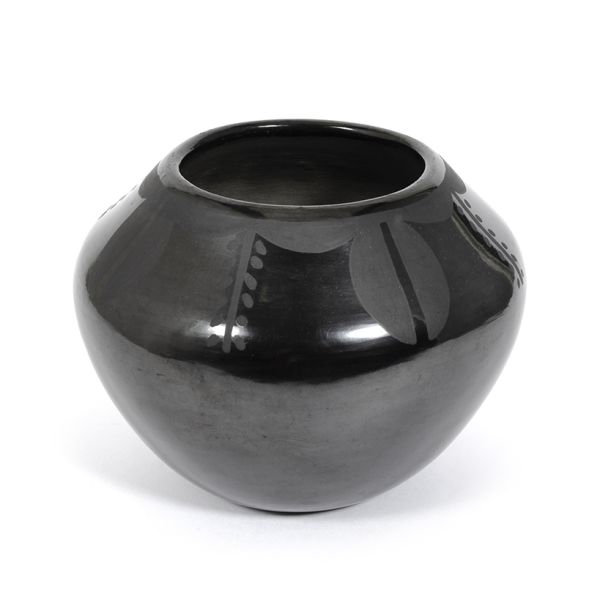BLACKWARE POT BY MARIA MARTINEZ (SAN ILDEFONSO)
$2,640.00
SKU
141184341
BLACKWARE POTTERY BY MARIA MARTINEZ (SAN ILDEFONSO)SIGNED MARIA + SANTANA
Maria Martinez was born Maria Montoya in 1887/89 and is recognized as one of the most famous Pueblo potters of the 20th Century. She learned the art of pottery making from her aunt Nicolasa as a child and was considered an accomplished potter by her teens. She married Julian Martinez (1897- 1943) in 1904. Originally, Maria made pots and Julian decorated them in the contemporary polychrome style. They demonstrated this technique at the 1904 World's Fair in St Louis, where they sold their pottery for a dollar a pot. This was their first exposure to a broad audience of collectors. In 1907, Julian was hired to help with archaeological excavations on the nearby Pajarito Plateau. Among the polychrome ware discovered were also black ware shards, which Maria saw in 1908 and set out to re-create. By 1918, through trial and error and much experimentation, they perfected a technique of black-on-black pottery where the surface design was separated by a matte and polished surface. Maria made the pots and Julian did the decoration. During this period of experimentation, the couple demonstrated for the 1915 San Diego World's Fair and raised the price of their pots to 2 dollars each. In 1925 their new work won "Best of Show" at the New York State Fair and in 1933 they took "Best of Show" at the Chicago World's Fair. Julian and Maria did not sign their early pottery but as their fame grew, they began to sign the work. Originally, only Maria signed the work because pottery was culturally a female occupation. Maria signed the work with just "Marie" from the early 1920's until 1925, thinking it would sound better to western collectors than Maria. From 1925 until Julian's death in 1943, they signed the work "Marie + Julian". After Julian's death, Maria's daughter in law Santana took over the role of decorating and the work she and Marie produced together between 1943-56 was signed "Maria + Santana". In 1956, Maria's son Popovi Da began working with her and by about 1959, they were signing their work "Maria + Popovi" (or "Maria + Poveka"). Around this time, Maria finally began using her name rather than "Marie".
measurements: 3 1/2" tall x 4 1/2" diameter, signed "Maria + Santana"
This is a consignment item and is not eligible for layaway.
Maria Martinez was born Maria Montoya in 1887/89 and is recognized as one of the most famous Pueblo potters of the 20th Century. She learned the art of pottery making from her aunt Nicolasa as a child and was considered an accomplished potter by her teens. She married Julian Martinez (1897- 1943) in 1904. Originally, Maria made pots and Julian decorated them in the contemporary polychrome style. They demonstrated this technique at the 1904 World's Fair in St Louis, where they sold their pottery for a dollar a pot. This was their first exposure to a broad audience of collectors. In 1907, Julian was hired to help with archaeological excavations on the nearby Pajarito Plateau. Among the polychrome ware discovered were also black ware shards, which Maria saw in 1908 and set out to re-create. By 1918, through trial and error and much experimentation, they perfected a technique of black-on-black pottery where the surface design was separated by a matte and polished surface. Maria made the pots and Julian did the decoration. During this period of experimentation, the couple demonstrated for the 1915 San Diego World's Fair and raised the price of their pots to 2 dollars each. In 1925 their new work won "Best of Show" at the New York State Fair and in 1933 they took "Best of Show" at the Chicago World's Fair. Julian and Maria did not sign their early pottery but as their fame grew, they began to sign the work. Originally, only Maria signed the work because pottery was culturally a female occupation. Maria signed the work with just "Marie" from the early 1920's until 1925, thinking it would sound better to western collectors than Maria. From 1925 until Julian's death in 1943, they signed the work "Marie + Julian". After Julian's death, Maria's daughter in law Santana took over the role of decorating and the work she and Marie produced together between 1943-56 was signed "Maria + Santana". In 1956, Maria's son Popovi Da began working with her and by about 1959, they were signing their work "Maria + Popovi" (or "Maria + Poveka"). Around this time, Maria finally began using her name rather than "Marie".
measurements: 3 1/2" tall x 4 1/2" diameter, signed "Maria + Santana"
This is a consignment item and is not eligible for layaway.



